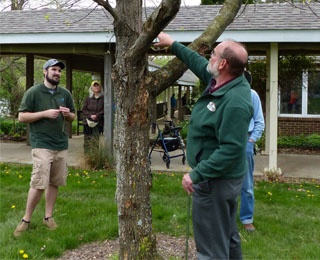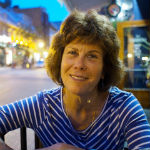Published: August 10, 2017
 One of the cornerstones of Kendal at Oberlin is its inviting natural environment. The campus encompasses over 100 acres, with more than 1,100 trees (50 different species) and eight ponds. With the grounds now accredited by ArbNet as The John Bartram Arboretum and ongoing resident-driven efforts, Kendal can now offer even more opportunities for enhancement and education.
One of the cornerstones of Kendal at Oberlin is its inviting natural environment. The campus encompasses over 100 acres, with more than 1,100 trees (50 different species) and eight ponds. With the grounds now accredited by ArbNet as The John Bartram Arboretum and ongoing resident-driven efforts, Kendal can now offer even more opportunities for enhancement and education.
“The arboretum is one of the most important, if not the most promising, developments at Kendal that I have experienced in my 25-year association with Kendal,” CEO Barbara Thomas said at this spring’s second annual Arbor Day celebration.
History of the John Bartram Arboretum
The John Bartram Arboretum at Kendal at Oberlin is named after a Pennsylvania Quaker and botanist from the 1700s. Often the Arboretum Subcommittee of the KORA Horticulture Committee begins its educational outreach by talking about its namesake.
A friend of Benjamin Franklin and other founding fathers, John Bartram collected specimens and seeds native to North America, which he distributed along the east coast and shipped overseas to Europe. He is considered the first American-born botanist.
Lots has been accomplished in the past two years since The John Bartram Arboretum achieved Level 1 accreditation from ArbNet, an international network of arboretums and other tree-focused institutions founded by the Morton Arboretum in Illinois. Of the nearly 2000 certified arboreta listed on the register, Kendal’s is the only one named for John Bartram. It is the only arboretum in Northeast Ohio to be located at a retirement community.
What Arboretum Folks Are Currently Sowing
Before we review past accomplishments, let’s talk about a few projects underway.
With the help of Oberlin College Environmental Studies students, a tree assessment was completed. Unfortunately, the results are troubling.
“About 80 percent of our trees are suffering and not thriving because they were either dug too deep or mulched too high, or both. We are at the beginning of deciding what to do next,” explains Chair Larry Dunn.
Think of it as triage, Larry says: “Remediation of these root crown problems is expensive, so we need to determine what trees can be saved, and at what cost, and which trees are beyond saving.”
The arboretum’s new Commemorative Tree Donation program will help bring new trees to campus. So far, about 8 trees have been donated in memory or in honor of someone. Donation is $500, which covers the cost of acquiring a tree, planting and labeling it, maintenance and replacement if it dies within two years of planting. Committee members are consulting with donors to select tree type and site.
“We need to be sure we plant trees that will thrive here,” Arlene Dunn says.
Another area of concern is the soil. Kendal, like most post-war housing and commercial construction projects, was developed using heavy large-scale earth moving equipment. As a result, the soil was heavily compacted and lifeless. Committee members are now testing three methods in different locations to determine the most effective way to aerate and revitalize the soil, restoring its natural living ecosystem.
The committee plans to plant new trees in the three locations over the next year. “The first clue to how well the methods are working will be how easy it is to dig,” Larry says.
Community-wide interest in the arboretum is growing, as residents walk around campus and see test sites underway and other committee activities.
To help educate the community, Anne Helm is writing a monthly article for the Kendalight newsletter, with an accompanying display in the Heiser Lounge. In June, Anne wrote about planting a memorial Bur Oak at the city’s Westwood Cemetery.
“Our arboretum gave this baby oak to the city as part of our second Arbor Day celebration, since Oberlin had lost a number of very large trees at the cemetery in a storm last year. This Bur Oak will become a gorgeous, stately tree, living long past our lifetimes,” she wrote.
Anne’s most recent article is about “Mourning Our Ash Tree Loss Reflects Need for Diversity.”
The committee is also doing research on developing a Young Tree Training program, starting with pruning the youngest trees first, followed by restorative pruning on the healthiest older trees.
“Residents are frequently thanking us for what we are doing and are very appreciative of the efforts we’re putting into this,” Arlene says.
“And many of them want us to do more,” Melissa Reed adds.
Arboretum members work closely with Matt Hannon, Kendal at Oberlin grounds coordinator. A recent board of directors’ reorganization, fueled by a new strategic plan, will give members more voice.
“We will have a role to play in the new campus plan committee. It gives us a place to bring facts and analysis. We see it as a new era of tree care,” Larry says.
What Kendal Has Already Harvested at the Arboretum
A $5,000 grant from Kendal Charitable Funds in late 2015 helped launch the arboretum.
“Your support has enabled The John Bartram Arboretum to make substantial progress in achieving our vision of the arboretum as a source of new value to Kendal at Oberlin residents and administration and for the community at large,” Larry Dunn wrote in the final report for Charitable Funds.
Completed and ongoing arboretum activities include:
- About $10,000 raised from grants and private donations;
- A logo developed by resident Don Parker to be used in promotional materials;
- Interpretive tags added to planted trees;
- A web-based catalog listing all trees with GPS locations and observation notes being developed;
- Relationships forged and strengthened with Kendal’s Early Learning Center, City of Oberlin, Oberlin College Environmental Studies Department and Ohio Department of Natural Resources;
- Donated and assisted planting six fruit trees to the Oberlin City Legion Field Community Garden, managed by Zion Community Development Corporation:
- Two Arbor Day celebrations featuring public education.
This year’s Arbor Day speaker was Alan Siewert, Ohio Department of Natural Resources Regional Urban Forester. He talked about the public health, social, environmental and economic benefits of a healthy urban forest. The list included:
- trees produce oxygen and enhance respiratory health;
- trees provide important habitats for birds, insects and animal species;
- communities and business districts with healthy tree cover attract new residents, industry and commercial activity.
Arbor Day Foundation lists even more benefits.
“The net cooling effect of a young, healthy tree is equivalent to ten room-size air conditioners operating 20 hours a day. (U.S. Department of Agriculture)
If you plant a tree today on the west side of your home, in 5 years your energy bills should be 3 percent less. In 15 years the savings will be nearly 12 percent. (Dr. E. Greg McPherson, Center for Urban Forest Research)
Landscaping, especially with trees, can increase property values as much as 20 percent. (Management Information Services/ICMA)
The planting of trees means improved water quality, resulting in less runoff and erosion. This allows more recharging of the ground water supply. Wooded areas help prevent the transport of sediment and chemicals into streams. (USDA Forest Service)
ArbNet Grant and Accreditation Progress
Also this year The John Bartram Arboretum was one of six member arboretums to receive a $1,000 grant from ArbNet.
“The John Bartram Arboretum at Kendal at Oberlin was selected largely because its project was found to be collaborative, innovative, and have a broad impact on the arboretum community,” said Nicole Cavender, vice president of science and conservation at The Morton Arboretum. “ArbNet is proud to support projects that will not only educate visitors and advance tree conservation, but could also serve as blueprints for arboreta around the world.”
The committee will eventually seek Level II accreditation from ArbNet, which includes developing a tree collections policy. “It’s an important step for us to take at some point, but not at the top of the list,” Larry says.
For now, the committee has plenty of projects that are of higher priority.
Says Larry, “We, as a community, are going to have to face some tough decisions because we have a lot of work to do and there is never enough money.”
Join In
Are you interested in learning more about this collaborative, innovative project and Kendal at Oberlin? Learn more about the John Bartram Arboretum and other projects by the community-minded residents of Kendal at Oberlin by contacting us for a brochure, tour or more information.

Molly Kavanaugh frequently wrote about Kendal at Oberlin for the Cleveland Plain Dealer, where she was a reporter for 16 years.




